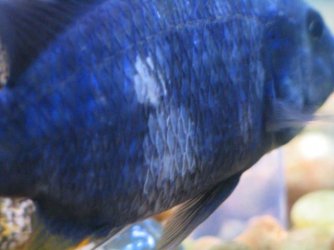tteel60625
New Member
- Joined
- Aug 17, 2006
- Messages
- 6
- Reaction score
- 0
I've got white something or other on one of my blue cichlids. I had one die when I was out of town, but my neighbor who was watching them just said that she flushed it down the toilet when she saw it floating. It was fine when I left and I was only gone 4 days. I've attached a pic so if anyone knows what this is, it would be greatly appreciated if you could offer some information.
Thanks!
As per requested... (went and bought a test kit)
Tank size: 55 Gallons
pH: 8.0
ammonia: 0
nitrite: .2 ppm
nitrate: 5.0 (low range), 25 (high range)
kH: (?)
gH: (?)
alkalinity: Between normal and low (On the scale they gave me)
tank temp: 84F
Fish Symptoms (include full description including lesion, color, location, fish behavior):
**swimming near the back corner of the tank, behind the rock. White "puffy" coating (see pic). Haven't seen him (or her) eat today.
Volume and Frequency of water changes:
**every 2 weeks, about 50%. Change every other filter, every two weeks.
Chemical Additives or Media in your tank:
**just went and bought Jungle brand "Lifeguard, All-in-one Treatment", figured it was a fungus, or something.
Tank inhabitants:
**4 other African cichlids, one plekostemus(sp).
Recent additions to your tank (living or decoration):
**none
Exposure to chemicals:
**none, only non-antibiotic treatment listed above (2nd treatment today)
Digital photo (include if possible): Attached.
Tank Life:
**almost a year.
Filter: Marineland Bio-wheel 330
Thanks!
As per requested... (went and bought a test kit)
Tank size: 55 Gallons
pH: 8.0
ammonia: 0
nitrite: .2 ppm
nitrate: 5.0 (low range), 25 (high range)
kH: (?)
gH: (?)
alkalinity: Between normal and low (On the scale they gave me)
tank temp: 84F
Fish Symptoms (include full description including lesion, color, location, fish behavior):
**swimming near the back corner of the tank, behind the rock. White "puffy" coating (see pic). Haven't seen him (or her) eat today.
Volume and Frequency of water changes:
**every 2 weeks, about 50%. Change every other filter, every two weeks.
Chemical Additives or Media in your tank:
**just went and bought Jungle brand "Lifeguard, All-in-one Treatment", figured it was a fungus, or something.
Tank inhabitants:
**4 other African cichlids, one plekostemus(sp).
Recent additions to your tank (living or decoration):
**none
Exposure to chemicals:
**none, only non-antibiotic treatment listed above (2nd treatment today)
Digital photo (include if possible): Attached.
Tank Life:
**almost a year.
Filter: Marineland Bio-wheel 330


 /article.discusnews.com/cat-02/columnaries.shtml
/article.discusnews.com/cat-02/columnaries.shtml